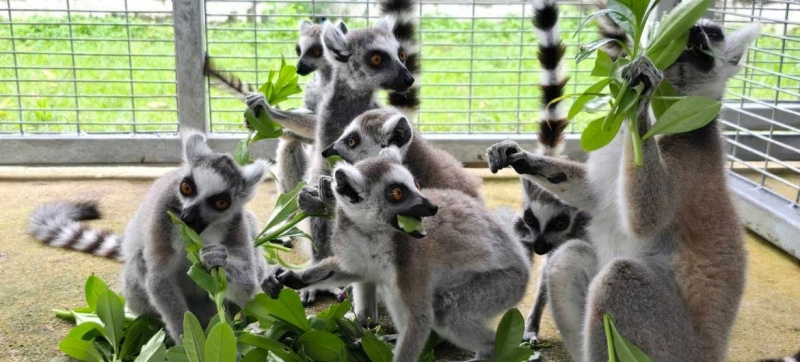
Ring-tailed lemurs return to Madagascar. Madagascar: Global animal rescue operation and nutritious insects Climate and environment
Nearly 1,000 lemurs and tortoises – vulnerable and endangered species – were returned from Thailand to Madagascar late last year, in one of the largest global repatriation operations in the fight against illegal wildlife trade.
The animals were seized as part of an international operation as they were being trafficked through Thailand for sale on the international illegal pet market. The operation was organized by Thai authorities with the support of the United Nations Office on Drugs and Crime (UNODC), the U.S. Fish and Wildlife Service and the Conservation Justice Commission. It resulted in the arrests of the suspected perpetrators in both Thailand and Madagascar.
The confiscated animals include ring-tailed lemurs (Lemur catta), brown lemurs (Eulemur fulvus), spider tortoises (Pyxis arachnoids), and radiated tortoises (Astrochelys radiata). Ring-tailed lemurs are considered endangered, while brown lemurs are considered vulnerable. Radiated and spider tortoises are classified as critically endangered, with the main threat to their survival coming from trafficking. All animals undergo testing and rehabilitation before being released into suitable habitats.
Insects Save Lemurs
Madagascar is renowned for its biodiversity, but that also makes its inhabitants, like lemurs, vulnerable to illegal trafficking. In addition, in some regions of the country, local populations use the meat of wild animals, including lemurs, as one of the main sources of protein in their diet.
A sustainable wildlife management programme offers the Sakondri insect (Zanna tenebrosa) as an alternative to game, helping to protect Madagascar’s endangered primates, lemurs, from hunting.
The programme, run by the Food and Agriculture Organization of the United Nations (FAO), the Centre for International Forestry Research, the French Centre for Agricultural Development and the Wildlife Conservation Society, aims to restore the balance between food needs for local people and wildlife conservation.
The Sakondri initiative thus provides a sustainable and nutritious alternative to animal meat. However, Sakondri populations have also been declining due to climate change, forest degradation and improper harvesting.
Beans to the Rescue
In response, it has been suggested to grow moon beans (Phaseolus lunatus), or cidimi beans as they are known locally.
In addition to providing food for humans, they provide food for the Sakondri, who are attracted to the plant’s nectar, and also add nitrogen to the soil, preventing erosion. This dual benefit ensures a steady supply of protein from both the insects and the beans, while reducing the negative environmental impact.
Sakondri themselves are extremely nutritious, with 20.1 grams of protein per 100 grams, comparable to chicken, pork, and beef. They are also higher in potassium, calcium, and iron than traditional animal protein sources. When combined with beans, this provides a significant contribution to the nutrition of local communities.
The Perfect Choice
Unlike traditional livestock farming, Sakondri farming requires less water, feed and space, and produces less greenhouse gases. These insects do not require supplementary feeding and do not damage other crops, making them an ideal choice for sustainable agriculture.
The minimal investment and resources required for insect farming create income opportunities, especially for rural women. In the future, the practice can be scaled up and Sakondri will be sold in local markets, providing additional income for families.
